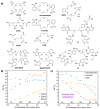The Advancement of Targeted Alpha Therapy and the Role of Click Chemistry Therein
- PMID: 40142070
- PMCID: PMC11944744
- DOI: 10.3390/molecules30061296
The Advancement of Targeted Alpha Therapy and the Role of Click Chemistry Therein
Abstract
Recent years have seen a swift rise in the use of α-emitting radionuclides such as 225Ac and 223Ra as various radiopharmaceuticals to treat (micro)metastasized tumors. They have shown remarkable effectiveness in clinical practice owing to the highly cytotoxic α-particles that are emitted, which have a very short range in tissue, causing mainly double-stranded DNA breaks. However, it is essential that both chelation and targeting strategies are optimized for their successful translation to clinical application, as α-emitting radionuclides have distinctly different features compared to β--emitters, including their much larger atomic radius. Furthermore, upon α-decay, any daughter nuclide irrevocably breaks free from the targeting molecule, known as the recoil effect, dictating the need for faster targeting to prevent healthy tissue toxicity. In this review we provide a brief overview of the current status of targeted α-therapy and highlight innovations in α-emitter-based chelator design, focusing on the role of click chemistry to allow for fast complexation to biomolecules at mild labeling conditions. Finally, an outlook is provided on different targeting strategies and the role that pre-targeting can play in targeted alpha therapy.
Keywords: chelators; click chemistry; complexation; pre-targeting; radionuclides; recoiling daughters; targeted alpha therapy; targeting vectors; tumors.
Conflict of interest statement
The authors declare no conflict of interest.
Figures








Similar articles
-
Targeted alpha therapy: part I.Curr Radiopharm. 2011 Jul;4(3):176. doi: 10.2174/1874471011104030176. Curr Radiopharm. 2011. PMID: 22201706
-
Progress in Targeted Alpha-Particle Therapy. What We Learned about Recoils Release from In Vivo Generators.Molecules. 2018 Mar 5;23(3):581. doi: 10.3390/molecules23030581. Molecules. 2018. PMID: 29510568 Free PMC article. Review.
-
Alpha-emitters for immuno-therapy: a review of recent developments from chemistry to clinics.Curr Top Med Chem. 2012;12(23):2642-54. doi: 10.2174/1568026611212230002. Curr Top Med Chem. 2012. PMID: 23339760 Review.
-
Advances in Precision Oncology: Targeted Thorium-227 Conjugates As a New Modality in Targeted Alpha Therapy.Cancer Biother Radiopharm. 2020 Sep;35(7):497-510. doi: 10.1089/cbr.2020.3568. Epub 2020 Apr 7. Cancer Biother Radiopharm. 2020. PMID: 32255671 Free PMC article. Review.
-
Development of Targeted Alpha Particle Therapy for Solid Tumors.Molecules. 2019 Nov 26;24(23):4314. doi: 10.3390/molecules24234314. Molecules. 2019. PMID: 31779154 Free PMC article. Review.
References
-
- Dekempeneer Y., Keyaerts M., Krasniqi A., Puttemans J., Muyldermans S., Lahoutte T., D’huyvetter M., Devoogdt N. Targeted alpha therapy using short-lived alpha-particles and the promise of nanobodies as targeting vehicle. Expert. Opin. Biol. Ther. 2016;16:1035–1047. doi: 10.1080/14712598.2016.1185412. - DOI - PMC - PubMed
Publication types
MeSH terms
Substances
LinkOut - more resources
Full Text Sources
Medical

